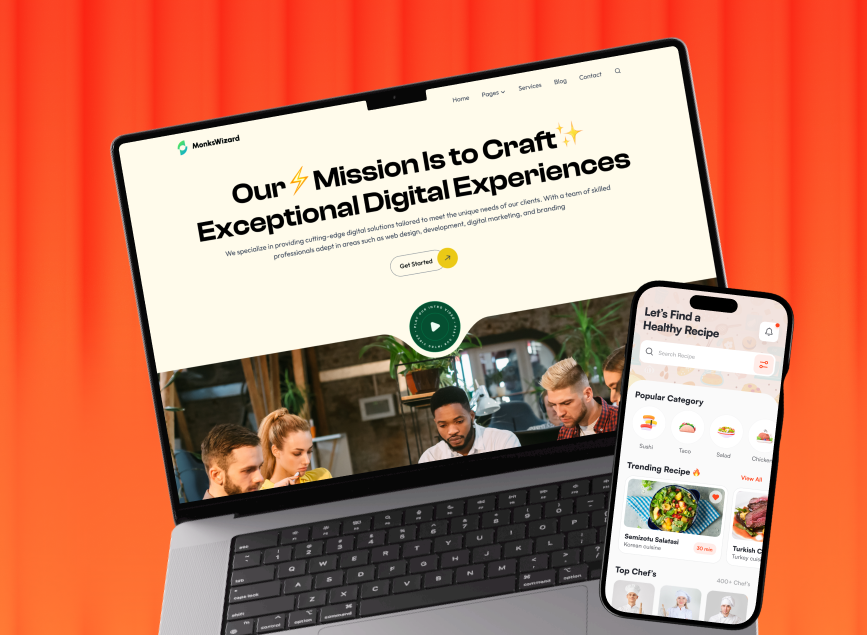
Key Takeaways
If you are always attached to the tech world, you must hear about the new wave in this section, UX Engineering. This term has become the talk of the town as it refines how digital products are designed and built.
It’s a hybrid field that combines the creative finesse of design with the technical power of engineering. Here, the goal is to ensure that user interfaces are visually perfect and highly functional, at the same time.
However, you must be seeing this because you are curious about the term, UX engineering. If that’s true, you are on the right page. Today, I’ll tell you everything about this new wave to make things clear for you. So, stay connected till the end to get rid of all your confusion.
What Does UX Engineering Mean?

UX Engineering is multidisciplinary, I mean a hybrid role that combines the roles of UX design and development to create seamless, user-friendly digital experiences. A UX Engineer prioritizes the principles of user experience design and the front-end development facts at the same time.
They need to work closely with UX designers who usually translate wireframes and prototypes into code. Their collaboration aims to ensure that the final product is both aesthetically pleasing and functional.
Generally, UX Engineers focus on the technical feasibility of design concepts and they optimize the concepts for performance and accessibility. For that, they mostly use technologies like HTML, CSS, and JavaScript. Also, they utilize frameworks like React or Angular, to build responsive and interactive interfaces.
They try to understand both the user’s perspective and the technical constraints to create an iterative design. Their unique blend of skills lets them ensure that the end product meets design specifications and also delivers an intuitive and engaging user experience.
According to Google UXE,
“You’ll never have the same day. One day you might design an animation for an app, and the next day, you might write a machine learning algorithm.”
Tyler F, UXE at Google
The Roles and Responsibilities of a UX Engineer
As mentioned earlier, UX engineers always have a mixed set of responsibilities that combine the skills of both a front-end developer and a UX designer. Their goal is to ensure that the product is both technically sound and user-friendly.
However, a UX engineer has a lot of responsibilities. Let’s check out the brief details of their roles.
Work in Collaboration
UX engineers need to work closely with both designers and developers. So, collaboration is their core working strategy. They have to write the necessary code to help turn design ideas into working products.
Also, they make sure that the final product looks according to the designer’s intention. Keeping everyone on the same page is also a part of their responsibility that helps the project run smoothly.
Prototype and Testing
Creating interactive models or prototypes of the products is another task of a UX engineer. These models let them interact with the product as a user before it’s fully built.
This strategy helps them gather feedback from these tests. As a result, they easily identify areas of improvement and ensure the product is easy and enjoyable to use.
User Journey Analysis
They also have to look at the entire user journey very closely. It is the path users take when interacting with a product. UX engineers have to analyze how users move through the product.
They also need to identify any user pain points or areas of confusion. This approach helps them make changes to improve the overall user experience.
Front-End Development
UX engineers’ prominent duty is to write the code that users see and interact with on a website or app. This code will make sure the design looks right on different devices, loads quickly, and is easy to use. They use languages like HTML, CSS, and JavaScript to build these front-end elements.
User-Centered Design Implementation
UX engineers always keep the user’s needs in mind. They make sure the product is designed to be as user-friendly as possible. They also need to confirm selective facts like ease of use and accessibility for people with disabilities. Their goal is to create products that people love to use.
These are not all. UX engineers usually have a hybrid set of responsibilities according to the project requirement. They need to be very hardworking and have a good sense of product design and front-end development. It’s because they always carry a heavier workload.
How Do the UX Engineers Work?

Like all other professions, UX engineering also has a set of steps on how they usually work. Learning these steps is essential to understand how their work is different from other professions.
However, the entire task of a UX engineer for a specific project is pretty much a longer process. That’s why, I have divided the entire project into 4 steps. Let’s check them out:
Step 1: Discussion and Ideation
UX engineers usually start their tasks for a project with the ideation phase. Here, they collaborate with designers, product managers, and stakeholders to discuss the project. With all the gathered ideas, they simply brainstorm and conceptualize new features or products.
While discussing, they try to understand user needs, business goals, and technical constraints. At the same time, they contribute with their technical expertise to help identify specific solutions and innovative ideas.
During this phase, they also need to create rough sketches or wireframes to visualize initial concepts. This collaborative approach ensures that the ideas generated are creative and technically acceptable. With the approval of other involved people, they start the first stage of development.
Step 2: UX and UI Design
The second step is the design phase. UX engineers collaborate with UX/UI designers and translate ideas into detailed mockups and prototypes. They provide feedback on design feasibility.
Also, they propose solutions that can be realistically implemented within technical constraints. UX engineers also develop interactive prototypes using tools like Figma, Sketch, or Adobe XD.
These prototypes allow early user testing and iteration and finally make it easier to refine the design based on feedback. They try to understand both design principles and technical aspects to ensure that the designs are at the same time, aesthetically pleasing and practical.
Step 3: Build and Develop
In the third phase, UX engineers transition from design to actual development. They write the front-end code using HTML, CSS, JavaScript, etc. Also, they make frameworks like React, Angular, or Vue.js to implement the designs. Their goal is to create a responsive, accessible, and performant user interface according to the designer’s vision.
Throughout this phase, they collaborate with developers to integrate the UI with server-side logic and data. The target is to ensure that the code is maintainable and scalable.
For that, they often set up component libraries or design systems. They meticulously build the front end and bring the design to life in a functional, interactive product.
Step 4: Testing
Testing is a critical phase and it is the last one here. As the design and development part is already taken care of, UX engineers work to ensure the product’s accessibility, usability, and overall quality.
Generally, they use it to confirm that the product works as intended to provide a seamless user experience. For that, they conduct different testing methods like usability testing, to gather real user feedback on the interface.
They also perform technical tests like cross-browser compatibility, performance testing, and accessibility checks to ensure the product meets all requirements.
Once they identify any issues or bugs, they fix them accordingly. This is an iterative process of testing and refining that cycles around the product. This approach helps to fine-tune the product and finally make it more robust and user-friendly.
So, these are the 4 basic steps UX engineers follow to complete a project. But these may not be all they do. According to the products’ needs and clients’ requirements, they can change their basic strategies and follow different methods.
Differences between UX Design and UX Engineering
For sure, UX design and UX engineering ain’t the same thing. From focus to their responsibilities, they have differences in almost everything. However, people often mix these two terms together and get a misconception. Here are the core differences between UX design and UX engineering:

They Have Different Focuses
The primary distinction between UX Design and UX Engineering is their focus. UX Design simply prioritizes creating a user-friendly and visually perfect experience.
Designers focus on user needs and behaviors to create intuitive interfaces and make them engaging and aesthetically pleasing. They prioritize how users interact with a product and they design it accordingly.
On the other hand, UX Engineering focuses on the technical implementation of these designs. Engineers work to translate the visual and interaction designs into functional code.
Their primary concern is to make sure that the designs are accurately realized in the final product, maintaining functionality and performance. So, they have focused on more aspects than what UX designers do.
Their Responsibilities Are not the Same
In terms of responsibilities, UX Designers and UX Engineers have variations. Even though they share some similarities, their core responsibilities are different.
UX Designers generally need to conduct user research, wireframing, prototyping, and visual design. They conduct user interviews, surveys, and usability testing to gather insights. They also manage the visual aspects of the design, such as typography, color schemes, and iconography.
In contrast, UX Engineers prioritize front-end development and maintain design systems. They write the HTML, CSS, and JavaScript necessary to bring the designs to life. Also, they ensure the product is responsive and performs well. At the same time, they develop and manage design systems to maintain consistency.
They Have Dedicated Tools to Use
The tools that UX Designers and UX Engineers commonly use, are customized according to their specific tasks. UX Designers commonly use design tools like Sketch, Figma, Adobe XD, InVision, and Balsamiq to create wireframes, prototypes, and high-fidelity designs. These tools help them visualize and iterate on their ideas efficiently.
UX Engineers, however, use development tools like VS Code, Git, npm, webpack, etc. For making frameworks, they use tools like React, Angular, or Vue.js. These tools let them write and manage code, track changes, and ensure the final product functions as intended.
They Require Different Sets of Skills
In terms of skills, they also have their differences. UX Designers need a strong understanding of design principles, user-centered design, empathy, and creativity.
UX Engineers, on the other hand, need proficiency in front-end programming languages like HTML, CSS, and JavaScript. They also need to understand design principles to implement designs accurately and effectively.
Besides, in the job section, UX designers and UX engineers have different levels of demands.
Connection Between UX Engineering And Web Development
UX engineers have a deep connection with web developers. Eventually, their connection is way more integral with web developers than UX designers. Still, their responsibilities sometimes overlap.
However, these two professionals are connected on different aspects of the development process. Here’s how they connect and complement each other:
Develop the Project Together
Both UX Engineers and Web Developers work on the front-end. Here, UX Engineers focus more on translating design into code. That’s why they prioritize Web Developers who may also handle front-end tasks but have a broader scope, they are more connected with back-end systems.
Check Each Other’s Progression
While working on the same project, both web developers and UX engineers need to check one other’s project. It is essential to make a collaborative approach to make sure that both are on the same track. Also, they share feedback on other’s progress to make the product even more user-friendly.
Share Research Findings
In the initial stage of designing or developing a project, UX engineers and web developers sit together for a group discussion. UX designers also join them as all of them need to work on the same product. In this phase, they share research findings to build a solid ground for the project.
Work Together on Prototypes
These two professionals also work together in the prototype section as well. UX engineers work to refine prototypes with the technical feedback from the web developers. They aim to make sure that the design is feasible and user-friendly.
Coding and Implementation
As both need to work with coding, they have a collaboration in this case as well. Here, the web developers must implement the designs. Following the developer’s work, the UX designers provide feedback on the implementation and finally, make sure that it aligns with their design vision properly.
So, this is how UX engineers and web developers are interconnected while working on a project.

FAQs
Do UX engineers need coding knowledge?
Yes, UX engineers need coding knowledge. They must be proficient in front-end technologies like HTML, CSS, and JavaScript, as well as frameworks like React or Angular. This coding knowledge helps them implement and fine-tune the user interface designs they work on.
Is it easy for a UX designer to be a UX engineer?
Transitioning from UX designer to UX engineer can be challenging but not something impossible. As a UX designer, you need to learn coding and gain technical skills to be a UX engineer. In this case, your strong understanding of design principles gives you an advantage for sure.
What skills do I need to be a UX engineer?
To be a UX engineer, you need coding skills (HTML, CSS, JavaScript), design tool proficiency (Sketch, Figma), an understanding of UX principles, problem-solving abilities, and effective communication.

Wrap Up
For sure, UX Engineers play a very important role even if the term is pretty much a new thing. As a new term in the UX world, this professional section is already becoming hype. So, newbies are getting interested in this profession for a better career path.
Well, being a skilled UX engineer may not be very easy as it demands a strong knowledge of design and development at the same time. Still, practice makes a man perfect and it’s not impossible for any of you.
Essential skills for a UX engineer like proficiency in coding, design tools, UX principles, problem-solving, and effective communication can help you in this case. As a person with expertise in all these sections, UX engineers are always in high demand in the job section.

.svg)






.png)
.png)
.avif)
.png)


.png)
.png)
.png)
.png)



.avif)



